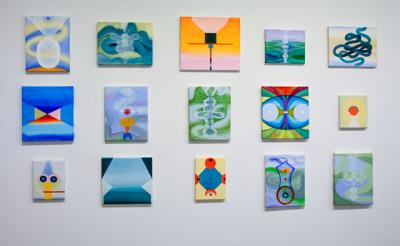Ille Arts Show Evokes Meaningful Themes

It is not too much of a stretch to see the latest exhibition at Ille Arts in Amagansett as evocative of the interior of a church or cathedral. Emily Cheng’s “Immensity of Particles,” a group of large and small abstract paintings, have the aura of icons. Marianne Weil’s “After Argos” is a series of glass and bronze sculpture, reminiscent of relics.
At first glance Ms. Cheng’s paintings seem to be geometric experimentation with no other implied content. But it soon becomes obvious that the concentric circles or complex polyhedrons in her compositions are part of a relationship with other, less explicable elements in the paintings.
By her own account, the artist works with themes such as wholeness, fragile beauty, and celebration to create living symbols. The paintings are not cold; they vibrate with implied energy and include elements that can be seen to refer to human lips, brains, eyes, and torsos.
She works in flashe, a vinyl paint used predominantly for road signs. It has a bold opaque impact but can be diluted to achieve the subtle effects she demonstrates in these paintings. Very little depth exists in these frontal, pure foreground canvases, yet the enveloping atmosphere makes the objects seem to float, adding an otherworldly effect.
Ms. Cheng finds inspiration in semiotic history, “cultural artifacts that leave visual clues to other civilizations and philosophies.” A seeker of meaning, she might use a drape, cloud design, or flower from sources dating back as far as 1000 B.C. or as recently as the 19th century as points of departure. She then links these objects as “testimonies to man’s drive to create order and leave synthesized expressions of meaning.”
This may sound heavy and fraught, but her joyful, light-infused color schemes keep the work friendly and approachable. It is only when viewers try to make sense of the objects and schemes she presents that the question of content and motive become somewhat ponderous. Is that a snake or asp (poison, foreshadowed death, original sin)? What about that egg (fertility, life, purity, oneness)? Is that a human soul in the flower she places in a starburst and frames in a complicated hexagon that emerges from a group of wavy lines that coalesce into something resembling a brain?
It’s hard to know if these responses are an overreaction, yet in a gallery full of visual information, it is nearly impossible not to ascribe some meaning. The artist said her method is to transform the fragments of the images she sees “in a way to express different internal states.” To do so, they often are transformed “or morphed so that the origin is now more remote, imbedded into the layers of the painting or drawing.”
Ms. Weil is also engaged in history and her approach also is visually indirect. Her forms are strong and dynamic, with the push and pull of the glass and bronze she uses, but she hints at history and classical mythology in the title of her show, “After Argos.”
In a cast bronze piece, “Argos Revisited,” metal mesh forms a grid creating frames for positive and negative space. Tiny cubes and tiny orbs form within the squares and extra mesh hangs off the sculpture like a fisherman’s net. Argos is an ancient Peloponnesian town incorporated into Greek mythology, most notably as the birthplace of Perseus, who slayed Medusa.
The pieces, often with titles that appear to be place names, seem like a sculptural postcard of associations and memories. They are placed on pedestals and tabletops, looking both diminutive and substantial. The permeable netting and the solid parts of the work along with the glass, where it exists, set up a yin and yang of hard and soft, positive and negative, the monumental and the unassuming.
The bronze cuffs, frames, and accents are not merely there to set off the glass, but the glass, with its various colors and bubbles, can steal the show. When certain pieces look like they could flow or topple, the implied control and chaos make the works even more compelling.
These shows will remain on view through Nov. 27.
